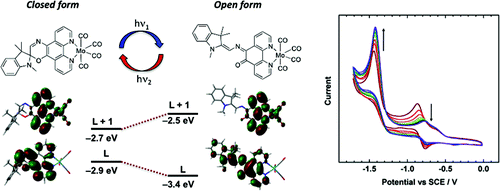当前位置:
X-MOL 学术
›
J. Am. Chem. Soc.
›
论文详情
Our official English website, www.x-mol.net, welcomes your
feedback! (Note: you will need to create a separate account there.)
Determining the Magnitude and Direction of Photoinduced Ligand Field Switching in Photochromic Metal–Organic Complexes: Molybdenum–Tetracarbonyl Spirooxazine Complexes
Journal of the American Chemical Society ( IF 14.4 ) Pub Date : 2011-07-06 , DOI: 10.1021/ja109776z Michelle M. Paquette 1 , Brian O. Patrick 2 , Natia L. Frank 1
Journal of the American Chemical Society ( IF 14.4 ) Pub Date : 2011-07-06 , DOI: 10.1021/ja109776z Michelle M. Paquette 1 , Brian O. Patrick 2 , Natia L. Frank 1
Affiliation

|
The ability to optically switch or tune the intrinsic properties of transition metals (e.g., redox potentials, emission/absorption energies, and spin states) with photochromic metal-ligand complexes is an important strategy for developing "smart" materials. We have described a methodology for using metal-carbonyl complexes as spectroscopic probes of ligand field changes associated with light-induced isomerization of photochromic ligands. Changes in ligand field between the ring-closed spirooxazine (SO) and ring-opened photomerocyanine (PMC) forms of photochromic azahomoadamantyl and indolyl phenanthroline-spirooxazine ligands are demonstrated through FT-IR, (13)C NMR, and computational studies of their molybdenum-tetracarbonyl complexes. The frontier molecular orbitals (MOs) of the SO and PMC forms differ considerably in both electron density distributions and energies. Of the multiple π* MOs in the SO and PMC forms of the ligands, the LUMO+1, a pseudo-b(1)-symmetry phenanthroline-based MO, mixes primarily with the Mo(CO)(4) fragment and provides the major pathway for Mo(d)→phen(π*) backbonding. The LUMO+1 is found to be 0.2-0.3 eV lower in energy in the SO form relative to the PMC form, suggesting that the SO form is a better π-acceptor. Light-induced isomerization of the photochromic ligands was therefore found to lead to changes in the energies of their frontier MOs, which in turn leads to changes in π-acceptor ability and ligand field strength. Ligand field changes associated with photoisomerizable ligands allow tuning of excited-state and ground-state energies that dictate energy/electron transfer, optical/electrical properties, and spin states of a metal center upon photoisomerization, positioning photochromic ligand-metal complexes as promising targets for smart materials.
中文翻译:

确定光致变色金属-有机配合物中光致配体场转换的幅度和方向:钼-四羰基螺恶嗪配合物
用光致变色金属配体配合物对过渡金属的固有特性(例如氧化还原电位、发射/吸收能和自旋态)进行光学切换或调整的能力是开发“智能”材料的重要策略。我们描述了使用金属羰基配合物作为与光致变色配体的光致异构化相关的配体场变化的光谱探针的方法。通过 FT-IR、(13)C NMR 及其钼的计算研究证明了闭环螺恶嗪 (SO) 和开环光部花青 (PMC) 形式的光致变色氮杂高金刚烷基和吲哚基菲咯啉-螺恶嗪配体之间配体场的变化-四羰基配合物。SO 和 PMC 形式的前沿分子轨道 (MO) 在电子密度分布和能量方面有很大不同。在 SO 和 PMC 形式的配体中的多个 π* MO 中,LUMO+1,一种基于伪 b(1)-对称菲咯啉的 MO,主要与 Mo(CO)(4) 片段混合并提供Mo(d)→phen(π*) 反键的主要途径。发现 LUMO+1 在 SO 形式中的能量比 PMC 形式低 0.2-0.3 eV,表明 SO 形式是更好的 π 受体。因此,发现光致变色配体的光致异构化导致其前沿 MO 的能量发生变化,进而导致 π 受体能力和配体场强发生变化。
更新日期:2011-07-06
中文翻译:

确定光致变色金属-有机配合物中光致配体场转换的幅度和方向:钼-四羰基螺恶嗪配合物
用光致变色金属配体配合物对过渡金属的固有特性(例如氧化还原电位、发射/吸收能和自旋态)进行光学切换或调整的能力是开发“智能”材料的重要策略。我们描述了使用金属羰基配合物作为与光致变色配体的光致异构化相关的配体场变化的光谱探针的方法。通过 FT-IR、(13)C NMR 及其钼的计算研究证明了闭环螺恶嗪 (SO) 和开环光部花青 (PMC) 形式的光致变色氮杂高金刚烷基和吲哚基菲咯啉-螺恶嗪配体之间配体场的变化-四羰基配合物。SO 和 PMC 形式的前沿分子轨道 (MO) 在电子密度分布和能量方面有很大不同。在 SO 和 PMC 形式的配体中的多个 π* MO 中,LUMO+1,一种基于伪 b(1)-对称菲咯啉的 MO,主要与 Mo(CO)(4) 片段混合并提供Mo(d)→phen(π*) 反键的主要途径。发现 LUMO+1 在 SO 形式中的能量比 PMC 形式低 0.2-0.3 eV,表明 SO 形式是更好的 π 受体。因此,发现光致变色配体的光致异构化导致其前沿 MO 的能量发生变化,进而导致 π 受体能力和配体场强发生变化。

































 京公网安备 11010802027423号
京公网安备 11010802027423号